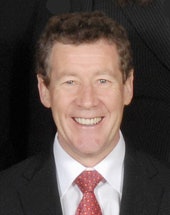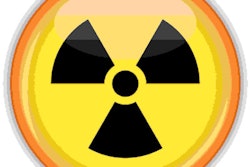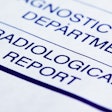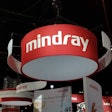Major reductions have been made in mammography radiation dose over the past 16 years, thanks to technological innovation and national quality standards such as the Mammography Quality Standards Act (MQSA). Despite this progress, many public health advocates -- as well as women of screening age -- are more worried about dose than ever.

To what extent should women and their healthcare providers worry about radiation dose? Are fears of radiation-induced cancers from breast imaging exams legitimate, or are they overblown? And what about alternative breast imaging technologies targeted at women who may be younger, have dense breast parenchyma, or have a higher risk for cancer?
X-ray-based mammography has always been one of the lowest of the low-dose imaging modalities. Cognizant of the health effects of serial screening exams taken annually or biennially (depending on the screening protocol), vendors and healthcare providers have worked hard to find new ways to reduce dose.
That said, even screening mammography produces radiation dose that in some rare cases can induce cancer. But numerous studies have found that the number of cancers detected by mammography offsets the much smaller number of radiation-induced tumors.
Things get more complicated when discussing some of the newer adjunctive imaging modalities that are arriving at many breast clinics. The topic got renewed attention in August 2010 with the publication of a new study indicating that two relatively new nuclear breast imaging modalities -- positron emission mammography (PEM) and breast-specific gamma imaging (BSGI) -- can involve radiation doses that produce up to 20 to 30 times the risk of radiation-induced fatal cancer than digital mammography in women age 40.
Aurora, CO
Scheduled to appear in the October issue of Radiology, the study rates the risks of digital breast tomosynthesis, conebeam CT, PEM, and BSGI. The bottom line: Radiopharmaceuticals injected in a single BSGI or PEM study have a far higher potential for inducing fatal radiation-induced cancer than x-ray-based mammography.
"I would certainly think two or three times before recommending BSGI or PEM to a patient," said the study's author, medical physicist R. Edward Hendrick, PhD, from the University of Colorado-Denver in Aurora.
Specifically, the standard dose of 740 to 1,100 MBq of technetium-99m (Tc-99m) sestamibi injected for a single BSGI study results in an effective radiation dose of 5.9 to 9.4 mSv. This dose is low when measured at the breast (2 mGy), but it's higher in the organs that clear the radiotracer from the system: 40 to 55.5 mGy to the large intestine wall and 20 mGy each to the kidneys, bladder wall, and gallbladder wall.
Hendrick's study found that this administered dose is associated with a lifetime attributable risk (LAR) of 26 to 39 cases of radiation-induced fatal cancer in 100,000 women age 40 years at exposure.
Meanwhile, PEM typically involves a standard dose of 370 MBq of FDG. This results in an estimated effective dose of 6.2 to 7.1 mSv, with the highest organ doses delivered to the bladder, uterus, and ovaries (59 mGy, 8 mGy, and 5 mGy, respectively). The lifetime attributable risk of fatal cancers at this level of exposure is 30 cases in 100,000 women age 40 years, or 23 times that of digital mammography in women age 40. This risk declines progressively with age, with 80-year-old women having half the risk of 40-year-olds for both BSGI and PEM studies.
In comparison, two-view digital mammography has a mean average glandular dose of 3.7 mGy, which is associated with a lifetime attributable risk of fatal radiation-induced cancer of 1.3 to 1.7 cases per 100,000 women. Analog mammography produces a slightly higher dose and LAR than digital mammography.
The report quickly generated headlines around the world, but should it be interpreted as a slam against nuclear breast imaging?
"I don't mean it to be sensational. I do mean to clarify that not all breast imaging modalities are the same," Hendrick said in an interview with AuntMinnie.com. "I think it's important to get that message out there, given the confusion around these nuclear medicine studies. That's something that some breast imagers didn't appreciate: the organ dosages when you administer radioactive agents."
Hendrick's analysis did not include molecular breast imaging (MBI), due to the modality's relative novelty compared to BSGI and PEM at the time the research was conducted. Unlike BSGI, which uses a dedicated breast gamma camera with a single detector head and analog sodium iodide scintillation crystals, the newest generation of MBI uses two semiconductor-based cadmium zinc telluride (CZT) digital detectors to capture more of the gamma rays emitted by the Tc-99m sestamibi tracer. It's based on technology developed at the Mayo Clinic in Rochester, MN, and licensed to Gamma Medica of Northridge, CA, which began selling the system in the U.S. this year.
The question of radiation dose is very much on the minds of researchers at Mayo, who are working on a pair of papers on the topic. The first is a study in which low-dose MBI was used to screen 2,500 women with dense breasts, while the second is a theoretical paper that calculates the number of radiation-induced cancers that might occur if that low-dose MBI protocol was used as part of a widespread screening program for women with dense breast tissue -- which would be the sweet spot for MBI as a screening tool, according to Michael O'Connor, PhD, a medical physicist at Mayo.
"The eventual goal is [that] we'd like to have an alternative to mammography for women with dense breasts," O'Connor said. "MRI is too expensive and ultrasound is time-consuming. We're thinking MBI would be an alternative. The question is: Would it work at 74- to 148-MBq doses?"
To develop the low-dose technique, the Mayo team replaced the MBI system's lead collimator with one made from tungsten, then matched each hole in the collimator to an individual pixel in the CZT detector. This yielded a nearly threefold improvement in sensitivity with no loss in spatial resolution.
Next, they shifted to a wider energy window (110-154 keV), which produced more photon counts and resulted in a 150% to 200% gain in sensitivity with minimal loss of contrast. The changes are possible due to the MBI system's use of CZT detectors rather than sodium iodide scintillation crystals, O'Connor said.
The current low-dose screening protocol requires a radiopharmaceutical dose of 148 MBq, compared with the current standard dose of 740 MBq for MBI. Ultimately, Mayo researchers hope to get the radiotracer dose as low as 74 MBq, O'Connor said; less than that is probably beyond the physical limitations of the current instrumentation.
The low-dose technique is being used in the screening study of 2,500 women with dense breasts to test its effectiveness. The paper is scheduled to be published in an upcoming issue of Radiology.
Next, the Mayo researchers turned to examining the risk-benefit ratio of MBI studies performed at such low levels of radiation in a screening population. Using similar radiation risk models as in the Hendrick study, they calculated the risk-benefit ratios of using MBI in various populations of women with dense breasts, as this is the most challenging group for mammography. Publication of this study is scheduled for an upcoming issue of Medical Physics.
First, the researchers based their model on a standard dose of 925 MBq of Tc-99m sestamibi, which produced a benefit-risk ratio of approximately 5:1 if it were administered annually from age 40 to 80 in women with dense breasts. This means that among a population of 100,000 dense-breasted women, standard-dose MBI could cause 453 cancer deaths but save 2,408 lives.
This benefit-risk ratio worsens among younger women with dense breasts, however. A woman with extremely dense breast tissue has five times the risk relative to a woman with fatty breast tissue. In dense-breasted women, therefore, performing annual 925-MBq MBI exams for women ages 40 to 49 produces a risk-benefit ratio of roughly 1:1 -- meaning that standard-dose MBI would cause as many deaths as it prevented in this hypothetical scenario.
That ratio improves markedly with Mayo's low-dose protocol, however. When the model is changed to use a Tc-99m dose of 111 MBq (halfway between the 74 to 148 MBq the Mayo team is targeting), the result is a ratio of roughly eight cancer deaths reduced for each one caused in a dense-breast population of women ages 40 to 49. The findings get even better when women of all ages are included: The low-dose protocol produces a benefit-risk ratio of 46:1 for women ages 40 to 80 with dense breasts.
While low-dose MBI undergoes research evaluation, there are explorations on other fronts. Digital breast tomosynthesis is still under development; Hendrick's review notes that radiation doses for this technique are one to two times the doses from two-view mammography.
Another option is dedicated breast CT, also not yet commercialized in the U.S., which will likely produce a radiation dose similar to or slightly higher than two-view mammography. As with mammography but unlike the nuclear medicine techniques, radiation is absorbed only in the breast tissue. Hendrick estimates that lifetime attributable risk for both digital breast tomosynthesis and dedicated breast CT would be one to two times those associated with two-view mammography.
Though MBI will not find smaller tumors due to inherent limitations ("At 4 mm you run into trouble based on the physics of the detectors," O'Connor said), MRI may be too sensitive, picking up benign processes or very small tumors that the body will reabsorb, according to Mayo researchers. It's also costly at more than $1,100 per exam, compared with $300 for a mammogram and an expected reimbursement of $500 per MBI exam at the Mayo Clinic. This is comparable to the price for a BSGI scan.
What's more, the cost of the radiotracer used in MBI has plummeted since Tc-99m sestamibi went off patent about a year ago, dropping from $150 a dose to $25 for a vial, according to O'Connor. The MBI scanner costs roughly $450,000.
There is another inexpensive, nonionizing option: ultrasound. However, a recent American College of Radiology Imaging Network (ACRIN) trial, ACRIN 6666, of whole-breast ultrasound and MRI in a population at high risk for breast cancer, did not make a resounding case for ultrasound as a screening method, according to O'Connor, due to false positives and cost-effectiveness questions regarding the length of the exam. Adding a single screening ultrasound to mammography yielded an additional 1.1 to 7.2 cancers found per 1,000 high-risk women, but it also substantially increased the number of false positives.
In other words, mitigating breast imaging radiation will be a concern well into the foreseeable future.
When analyzing the potential effects of medical radiation dose, several factors need to be considered: First, humans are already exposed to radiation in their natural environment. Second, no one really knows for sure the true health impact of radiation at very low levels.
Both Hendrick and O'Connor place their dose analysis in the context of the average annual effective dose a person receives from background radiation in the natural environment: about 3 mSv. This natural radiation exposure varies by location -- ironically, Hendrick resides in Colorado, where both cosmic and terrestrial radiation are greater by a factor of 1.5 than elsewhere in the U.S., thanks to high altitude and uranium-enriched soils. Hendrick's paper notes that effective dose from BSGI and PEM studies equals approximately two to three years of natural background radiation exposure.

But one needs to also keep in mind the cumulative effect of natural background radiation, which begins hitting individuals the day they are born, according to O'Connor. If women received an MBI screening study at the higher 925-MBq dose every year between the ages of 40 and 80, the number of deaths caused by radiation from those exams would be half the number caused by natural background radiation, O'Connor said.
"The cumulative effect of background radiation over your life is far, far greater than any of these medical procedures," O'Connor said.
What's more, no long-term population-based studies have been conducted that track how many patients developed cancer from the relatively low levels of radiation produced by medical imaging studies. Instead, estimates such as lifetime attributable risk are based on the linear no-threshold theory, which starts with death rates found in cases of high levels of radiation exposure, such as the Chernobyl nuclear accident or the Japanese atomic bomb attacks, and extrapolates them to much lower exposure levels like those found in medical imaging.
Ultimately, medical physicists like O'Connor and Hendrick see increasing the awareness of patients and physicians about medical radiation as a never-ending responsibility. The challenge was chronicled in a July 2008 article in Radiology by Mettler and colleagues.
"Most physicians have difficulty assessing the magnitude of exposure or potential risk," the authors wrote. "Effective dose provides an approximate indicator of potential detriment from ionizing radiation and should be used as one parameter in evaluating the appropriateness of examinations involving ionizing radiation" (Radiology, Vol. 248:1, pp. 254-263).
Hendrick observed that these difficulties exist at the highest levels: "Even the 2009 [U.S. Preventive Services Task Force] report on mammography and its benefits and harms misestimated the dose and, therefore, the risk from mammography. The major part of the decision wasn't based on the risk of radiation-induced cancers, but they overstate the risks and then they don't discuss them. They didn't do a complete job, let's put it that way, of estimating the risk," said Hendrick, who plans to submit a paper on the topic to the American Journal of Roentgenology.
"Absorbed dose is energy deposited per unit mass of tissue," he continued. "You don't add the dose to the first breast to the second breast. This is what a first-year radiology resident learns when they cover absorbed dose."
As nuclear medicine and CT-based modalities gain traction in breast imaging, a new understanding of the needs of specific female populations based on age, breast density, disease, or genetic risk factors may accumulate. In its 2008 report on ionizing radiation, the United Nations Scientific Committee on the Effects of Atomic Radiation (UNSCEAR) named just two special populations affected by radiation: children and fetuses. Could future reports recognize women?
"In pediatric patients, the message has gotten across, particularly to radiologists, that you really have to work as hard as possible to lower the dose in exams," Hendrick said. "They are less aware that the same dose to a female is greater than to a male, and that younger females have more risk. They have more radiosensitive organs than males, and, typically, for the same dose -- whether it's internally or externally administered -- females are smaller," Hendrick said.
O'Connor agrees that not enough attention has been paid to the effects of radiation on women's reproductive organs. But he also believes that any discussion of the risks of medical radiation exposure should be placed against the backdrop of natural background radiation.
"If you were really concerned about radiation, no one should be allowed to live in the Rocky Mountains," O'Connor said. "That would save more lives than all the medical radiation exposure."
By Alexandra Weber Morales
AuntMinnie.com contributing writer
September 14, 2010
Copyright © 2010 AuntMinnie.com



















